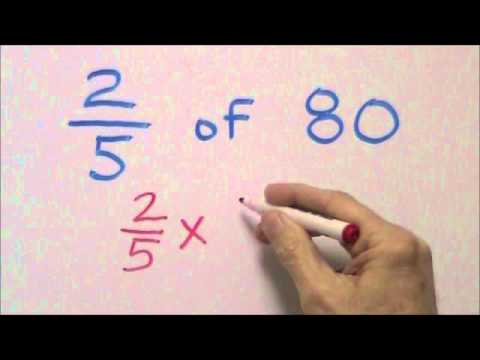Understanding how to calculate one-third of a number is a fundamental mathematical skill that is essential in many aspects of life and numerous practical situations. From dividing a recipe to splitting a bill, or understanding fractions in a more general sense, being able to find a third is a handy trick. This guide will take you through various ways to calculate a third, ensuring you have the skills required to tackle this problem whenever it arises.

Division by Multiplication
Finding one-third of any number is essentially a two-step process. First, you understand the principle behind division by multiplication, and then apply it directly.
Detailed Introduction:
Division by multiplication is a method used to find a fraction of a number. In this case, since one-third is the target, you’ll multiply the number by the reciprocal of 3.
Detailed Steps:
- Understand that one-third means the same as dividing by 3.
- Learn that the reciprocal of a number is a flipped version of a fraction. For 3, the reciprocal is 1/3.
- Multiply the original number by 1/3 to find one-third.
Summary:
This method is straightforward and quick, especially with a calculator. The potential downside is it requires basic knowledge of fractions and reciprocals, which might be confusing for some.
The Fractional Method
The Fractional Method employs the use of fractions to calculate one-third of a number, emphasizing a visual representation of division.
Detailed Introduction:
Fractions represent parts of a whole. In this method, you convert the number into a fraction to visualize and calculate one-third.
Detailed Steps:
- Express the number as a fraction with 1 as the numerator.
- Multiply this fraction by the fraction representing one-third, which is 1/3.
- Simplify the resulting fraction if necessary.
Summary:
This method is visual and can be easier to grasp for those who understand fractions well. However, simplifying fractions may be an additional step requiring more knowledge.
Using Decimals
Decimals provide an alternative route to calculating one-third by converting the fraction into a decimal equivalent.
Detailed Introduction:
One-third can be approximated as the decimal 0.333… (the 3s continue indefinitely). Multiplying a number by this decimal should give you roughly one-third.
Detailed Steps:
- Convert one-third into a decimal, which is approximately 0.333.
- Multiply the number you want to divide by 0.333.
- Round the result to the desired number of decimal places for accuracy.
Summary:
This method is particularly useful for quick calculations and when using a calculator. However, the result is an approximation, and the infinite nature of the decimal can lead to rounding errors.
The Long Division Method
Long division is a traditional method of dividing numbers without the aid of a calculator.
Detailed Introduction:
By working through each digit of the number and dividing it by 3, this manual process yields the exact one-third.
Detailed Steps:
- Write down the number you want to divide.
- Begin a long division by drawing a division bar and placing the number 3 outside of it.
- Divide each digit of the number by 3 in sequence.
- Write down the remainder, if any, above the next digit and continue the process until finished.
Summary:
This old-school method ensures an exact result without a calculator but can be time-consuming and requires comfort with basic division.
The Doubling and Halving Trick
Doubling a number and then finding its half can sometimes be easier than direct division.
Detailed Introduction:
This trick involves a simple rearrangement of the mathematical process to make mental calculations smoother.
Detailed Steps:
- Double the number you are trying to divide.
- Find half of this new number.
- Split the result from step two in half again to arrive at one-third of the original number.
Summary:
This method exploits easier calculations (like halving) and may speed up mental math. However, it involves more steps and thus can be more error-prone.
Estimation Technique
Sometimes an exact number isn’t necessary, and an estimate will do. This method is all about quick thinking and ballpark figures.
Detailed Introduction:
Estimation is a skill that enables you to make fast and serviceable predictions without needing precision.
Detailed Steps:
- Round the number to the nearest multiple of 3 for simplicity.
- Divide this number by 3 either mentally or with basic division skills.
- Recognize the result as an estimation of one-third of the original number.
Summary:
Estimation is ideal for when speed is more important than accuracy. The downside is that it’s not exact and shouldn’t be used when precision is required.
Grouping Technique
Grouping splits the number into three equal parts directly, which is helpful for visual learners or when dealing with tangible items.
Detailed Introduction:
Imagine you have a certain number of objects and need to divide them into three groups. Grouping does just that.
Detailed Steps:
- Count out the total number of items.
- Separate the items into three groups, ensuring each group has the same number of items.
- One group represents one-third of the total number.
Summary:
Grouping is an excellent approach when dividing physical items but less practical for abstract numbers and can be cumbersome with larger quantities.
Using Proportions
Proportions involve setting up an equation that relates different fractions to one another to solve for the unknown third.
Detailed Introduction:
Proportions can be set up to solve for one-third of a number by relating it to another known value.
Detailed Steps:
- Set up a proportion where one side is 1/3 and the other is an unknown (x) over the original number.
- Solve for x by multiplying both sides of the equation by the original number.
- Simplify the equation to solve for x, which will represent one-third of the original number.
Summary:
Proportions are mathematically elegant but may be too complex for those not familiar with solving equations, adding a layer of difficulty.
Multiplying by a Ratio
Ratios are another tool for visually representing parts of a whole, making it easier to multiply directly to find one-third.
Detailed Introduction:
A ratio compares two numbers, and multiplying by a ratio can simplify the process of finding a fraction.
Detailed Steps:
- Set up a ratio that represents one-third, which would be 1:3.
- Multiply the number by the first part of the ratio (1) and then divide by the second part of the ratio (3).
Summary:
Ratios provide a systematic approach to fractions and division, but again, this method assumes a comfortable understanding of the concept of ratios.
Trial and Error
When all else fails, trial and error can be a surprising ally in determining one-third, especially when learning or in casual settings.
Detailed Introduction:
In this least formal method, you take educated guesses to home in on what one-third might be.
Detailed Steps:
- Estimate what you think one-third of the number might be.
- Multiply this estimate by 3 to see if you get the original number.
- Adjust your estimate based on the result and repeat steps 1 and 2 until satisfied.
Summary:
Trial and error is good for learning and developing intuition but is the least precise and most time-consuming method presented.
In conclusion, calculating one-third of a number can be approached from various angles, depending on your preference, the context of the problem, and the tools at hand. Each method has its own merits, whether it’s the precision of long division, the quickness of estimation, or the visual appeal of fractions and ratios. Understanding different methods enhances flexibility and builds a stronger foundational skill set.
FAQs
Q: Why is it useful to know multiple methods for calculating one-third of a number?
A: Knowing multiple methods allows you to be adaptable and choose the best approach for the situation at hand. Some methods are faster, while others are more accurate, so having this flexibility is beneficial.
Q: Can I always use the decimal 0.333 to represent one-third precisely?
A: The decimal 0.333 is an approximation of one-third. It’s useful for quick calculations but is not exact since one-third is a repeating decimal and cannot be precisely represented with a finite number of digits.
Q: What should I do if I keep getting a remainder when trying to find one-third of a number?
A: If you’re encountering a remainder, you can express one-third of the number as a mixed number (combining whole numbers and fractions) or continue the division to more decimal places for a more precise result.









